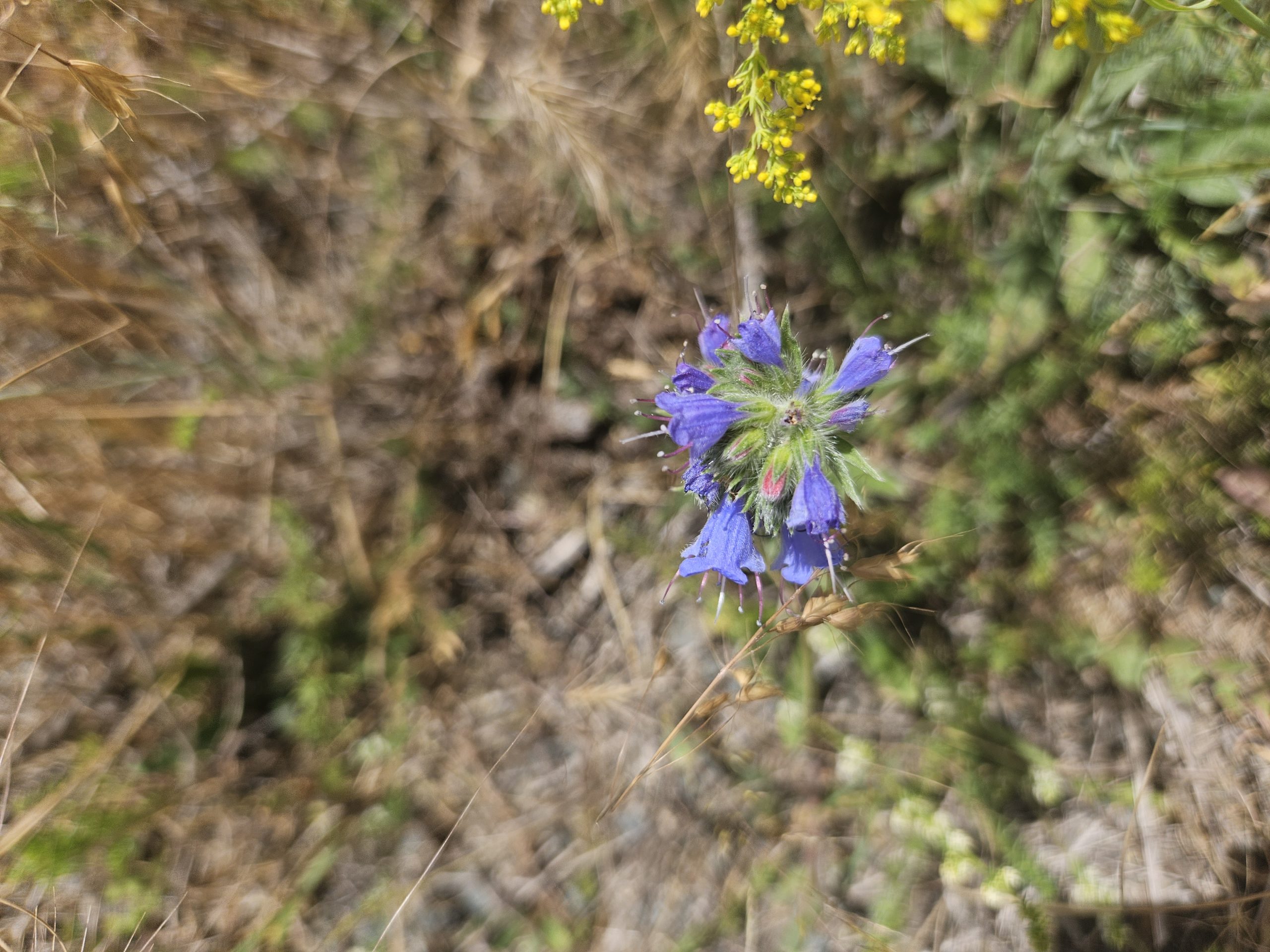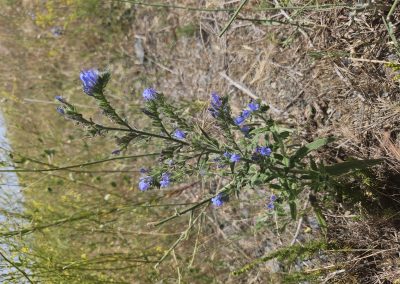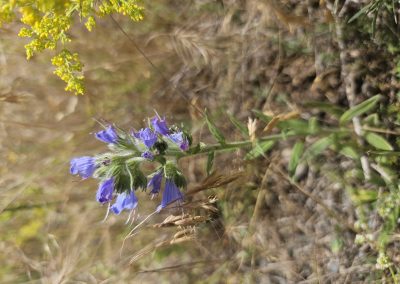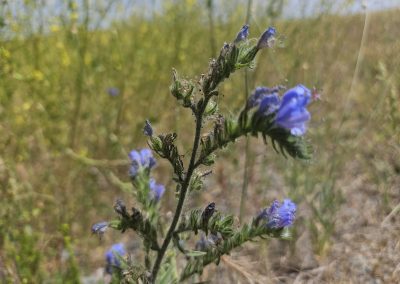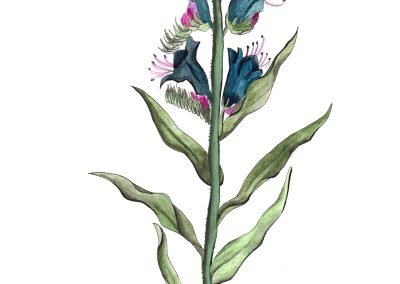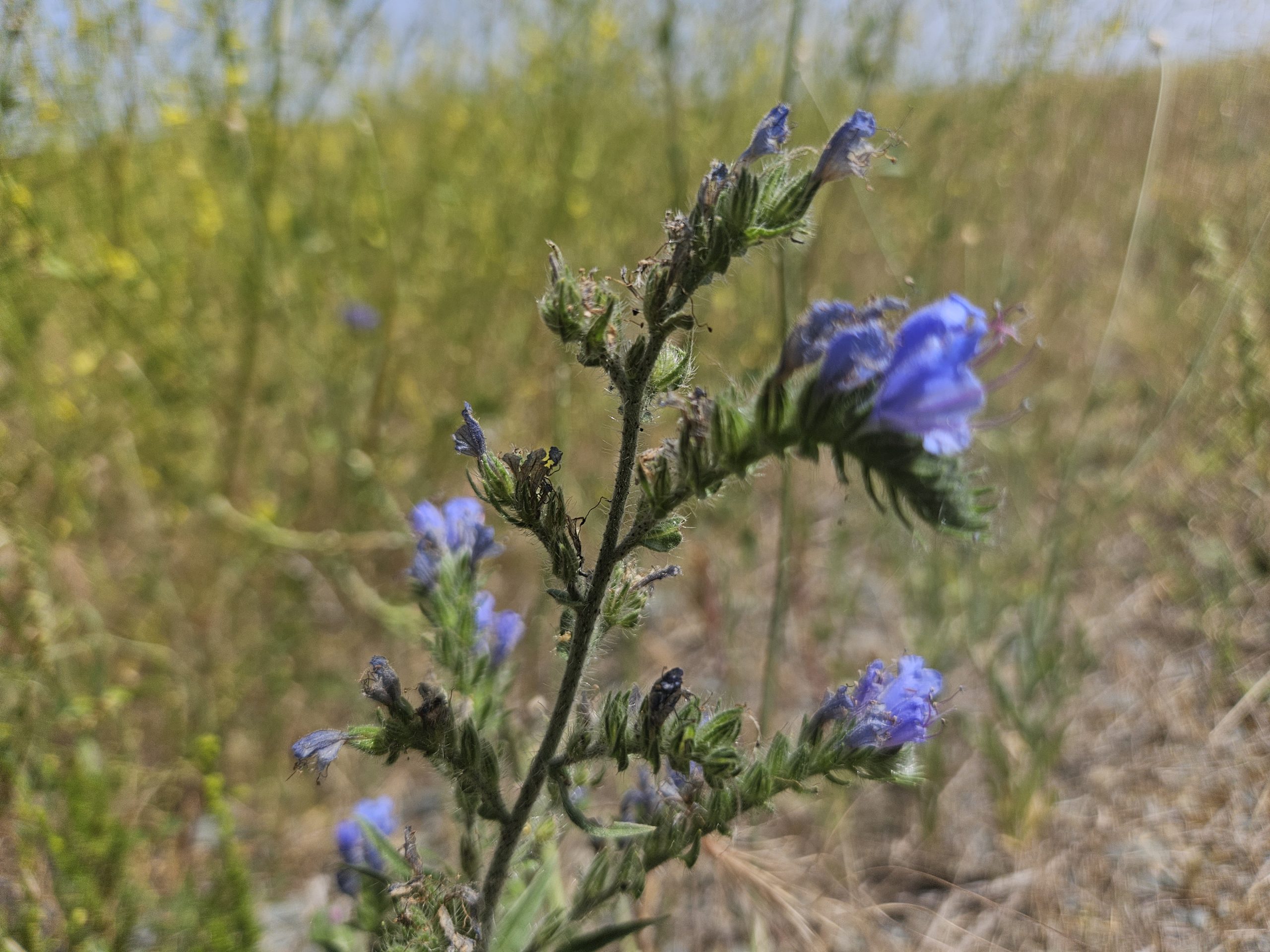Echium vulgare
Scientific description
Phylum: Angiospermatophyta (Magnoliophyta)
Class: Dicotyledonatae (Magnoliatae)
Subclass: Asterideae
Order: Boraginales
Family: Boraginaceae
Common names: viper's bugloss, blueweed.
Origin: Eurasian.
Description:
It is a biennial herbaceous plant with coarse, stiff, and prickly hairs. The root is a black taproot with numerous absorbing root hairs. The stem is erect, up to 1 meter tall, rigid, unbranched or branched from the base, covered with short soft hairs, interspersed with long, bristle-like hairs. The leaves are simple, without stipules, linear-lanceolate; the basal ones are petiolate and arranged in a rosette, while the stem leaves are sessile, single-veined, and hairy. The flowers are arranged in simple cymose inflorescences, are zygomorphic, and based on the number five. The calyx is formed of five linear-lanceolate, fused sepals; the corolla is funnel-shaped, without fornices, has five unequal lobes, slightly curved and bilabiate, pubescent and fused. The androecium consists of five curved stamens pointing upwards and fused to the corolla tube. The gynoecium features a nectar disc at the base, a long style ending in a bilobed stigma, with a superior position, and is bicarpellary. It blooms from May to July. The flowers are pink and turn vivid blue. The fruit is a nutlet.
Propagation: by seeds.
Ecology:
Common from lowland areas to hills, found in meadows, thickets, and ruderal places.
Uses:
It is a melliferous (honey-producing) plant with horticultural importance and can be cultivated as an ornamental plant. It also has medicinal uses; the stem tip and inflorescence, rich in allantoin and tannins, are used to treat diarrhea and enteritis. The seeds contain a large amount of fatty oil rich in linolenic and stearidonic acids and can be used to treat dyslipidemia.
Hazard: It is toxic to mammals due to its content of pyrrolizidine alkaloids, so in pasture areas, shepherds often eliminate it.
Încrengătura: Angiospermatophyta (Magnoliophyta)
Clasa: Dicotyledonatae (Magnoliatae)
Subclasa: Asterideae
Ordinul: Boraginales
Familia: Boraginaceae
Denumire populară: iarba mielului, iarba șarpelui.
Originea: euroasiatică.
Descrierea:
este o ierboasă bienală, având peri aspri, rigizi, înțepători. Rădăcina este pivotantă, neagră, cu numeroși perișori absorbanți. Tulpina este erectă, cu înălțimi de până la 1 metru, rigidă, neramificată sau ramificată de la bază, acoperită cu peri scurți moi, iar printre ei se găsesc peri lungi, setiformi. Frunzele sunt simple, nestipelate, linear–lanceolate; cele de la bază sunt pețiolate, dispuse în rozetă, cele tulpinale sunt sesile, uninerve, păroase. Florile sunt dispuse în inflorescențe cime simple, sunt zigomorfe, fiind organizate pe tipul cinci. Caliciul este format din cinci sepale linear–lanceolate, gamofile; corola infundibuliformă, fără fornice, are cinci lobi inegali, ușor curbați și bilabiați, pubescentă și gamofilă. Androceul este alcătuit din cinci stamine curbate, orientate în sus, unite cu tubul corolei. Gineceul are un disc nectarifer la bază, un stil lung, care se termină cu un stigmat bilobat, are poziție superioară și este bicarpelar. Înflorește din mai până în iulie. Culoarea florilor este roz și devin albastre viu. Fructul este nuculă.
Înmulțire: semințe.
Ecologie:
frecventă din zona de câmpie până în zonele de deal, prin pajiști, tufărișuri și locuri ruderale.
Utilizare:
este o plantă meliferă, cu importanță horticolă; se poate cultiva ca plantă de ornament. Are și întrebuințări medicinale: vârful tulpinii și inflorescența, bogate în alantoină și taninuri, se folosesc pentru tratarea diareei și enteritei. Semințele conțin o cantitate mare de ulei gras bogat în acizi linolenic și stearidonic și se pot folosi în tratarea dislipidemiei.
Pericol: prezintă toxicitate pentru mamifere datorită conținutului de alcaloizi pirolizidinici; în zonele de pășune este adesea eliminată de ciobani.
Γένος: Angiospermatophyta (Magnoliophyta)
Τάξη: Dicotyledonatae (Magnoliatae)
Υποκατηγορία: Asterideae
Τάξη: Boraginales
Οικογένεια: Boraginaceae
Δημοφιλές όνομα: αρνάκι, φιδόχορτο.
Καταγωγή: Ευρασία.
Περιγραφή:
Διετές ποώδες φυτό με τραχιές, σκληρές και αγκαθωτές τρίχες. Η ρίζα είναι πασσαλώδης, μαύρη, με πολυάριθμες απορροφητικές ριζοτρίχες. Ο βλαστός είναι όρθιος, έως 1 μ. ύψος, άκαμπτος, αδιακλάδιστος ή διακλαδισμένος από τη βάση, με κοντές μαλακές τρίχες και διάσπαρτες μακριές, σετιόμορφες τρίχες. Τα φύλλα είναι απλά, χωρίς παράφυλλα, γραμμοειδή–λογχοειδή· τα βασικά είναι μίσχοφυ και σε ροζέτα, ενώ τα βλαστοφόρα είναι άμισχα, μονόνευρα και τριχωτά. Τα άνθη βρίσκονται σε απλές κυμοειδείς ταξιανθίες, είναι ζυγόμορφα και οργανωμένα στον «αριθμό πέντε». Ο κάλυκας αποτελείται από πέντε γραμμοειδή–λογχοειδή, συμφυή σέπαλα· η στεφάνη είναι χωνοειδής, χωρίς θυρίδες, με πέντε άνισους λοβούς, ελαφρώς κυρτούς και διχειλείς, εφηβική και συμφυής. Το ανδρείο έχει πέντε καμπύλους στήμονες, στραμμένους προς τα πάνω, συμφυείς με τον σωλήνα της στεφάνης. Το γύνοικo φέρει νεκταροφόρο δίσκο στη βάση, μακρύ στύλο με διλοβο στίγμα, υπέρoχη θέση, δικαρπικό. Ανθίζει Μάιο–Ιούλιο. Τα άνθη είναι ροζ και γίνονται έντονα μπλε. Ο καρπός είναι αχένιο (nutlet).
Πολλαπλασιασμός: με σπόρους.
Οικολογία:
Κοινό από πεδινές έως λοφώδεις περιοχές, σε λιβάδια, θαμνώνες και ρουδερικές θέσεις.
Χρήσεις:
Μελιτοφόρο φυτό με κηποτεχνική αξία, καλλιεργείται και ως καλλωπιστικό. Έχει και φαρμακευτικές χρήσεις· η κορυφή του βλαστού και η ταξιανθία, πλούσιες σε αλλαντοΐνη και ταννίνες, χρησιμοποιούνται κατά της διάρροιας και της εντερίτιδας. Οι σπόροι περιέχουν πολύ λιπαρό έλαιο πλούσιο σε λινολενικό και στεαριδονικό οξύ και μπορεί να βοηθήσει στη δυσλιπιδαιμία.
Κίνδυνος: Τοξικό για τα θηλαστικά λόγω αλκαλοειδών πυρρολιζιδίνης· σε βοσκοτόπια συχνά απομακρύνεται από τους κτηνοτρόφους.
Phylum : Angiospermatophyta (Magnoliophyta)
Classe : Dicotyledonatae (Magnoliatae)
Sous-classe : Asterideae
Ordre : Boraginales
Famille : Boraginaceae
Noms communs : viper's bugloss, blueweed.
Origine : eurasiatique.
Description :
Plante herbacée bisannuelle, à poils grossiers, rigides et piquants. Racine pivotante noire avec de nombreux poils absorbants. Tige dressée, jusqu’à 1 m de haut, rigide, simple ou ramifiée dès la base, couverte de courts poils doux entrecoupés de longs poils soyeux raides. Feuilles simples, sans stipules, linéaires-lancéolées ; les basales sont pétiolées en rosette, les caulinaires sessiles, uninéervées et velues. Fleurs en inflorescences cymoïdes simples, zygomorphes et organisées sur le type cinq. Calice à cinq sépales linéaires-lancéolés, soudés ; corolle infundibuliforme, sans fornices, à cinq lobes inégaux, légèrement courbés et bilabiés, pubescente et soudée. Androcée : cinq étamines courbes dirigées vers le haut, soudées au tube de la corolle. Gynécée : disque nectarifère basal, long style à stigmate bilobé, ovaire supère, bicarpellé. Floraison de mai à juillet. Les fleurs sont roses puis deviennent d’un bleu vif. Le fruit est une nucule (nutlet).
Propagation : par graines.
Écologie :
Commune des basses terres aux collines, présente dans les prairies, fourrés et lieux rudéraux.
Usages :
Plante mellifère d’intérêt horticole, cultivable comme ornementale. Usages médicinaux : l’extrémité de la tige et l’inflorescence, riches en allantoïne et tanins, sont utilisées contre la diarrhée et l’entérite. Les graines contiennent une huile grasse riche en acides linolénique et stéaridonique, utile dans la dyslipidémie.
Danger : Toxique pour les mammifères (alcaloïdes de pyrrolizidine) ; en pâturage, elle est souvent éliminée.
Creative writing inspired by Echium vulgare
Written by Mara Parfinov
The Serpent’s Grass
Once upon a time, there was a distant little village. The inhabitants were very few, so doctors were rarely found. However, because of that, they had grown used to helping one another, whenever needed. But one day, a dangerous stomach disease appeared, spreading rapidly, and soon almost the entire village was affected. The people had no cure for this illness, and with each passing day, more and more of them began to perish.
One day, a thirteen-year-old girl named Lidia, who had a very sharp mind, came up with the idea of making a medicine to cure the disease. She searched through all sorts of books until she found some of the best ingredients used in remedies for various illnesses. One of these was a plant called the Serpent’s Grass. Lidia had no idea where to find this flower, but she first gathered the other ingredients: salt, pepper, cinnamon, and three seashells. Then, she went to the field near her house and started searching for the mysterious plant. She had studied it in books and learned that it was very good for stomach ailments and that it had a purple color. Two very useful pieces of information. She searched for hours but couldn’t find it. Just as she was about to give up, something shimmered in the sunlight. Something… purple! The girl stared in amazement, barely able to believe it, but at the same time, she felt excitement surging through her…she had finally found the much-desired plant. Carefully, she picked it from the field and took it home. She mixed the ingredients in a bowl with pure, untouched water, convinced that this was the way to obtain the perfect potion. The liquid in the vessel began to take on a strange, brownish hue, and a fine mist rose above its surface. Lidia was overjoyed: the medicine was ready. She took several bottles and filled them with the brown potion. Then, she went from door to door, handing them out, hoping that her remedy would work.
A week later, more and more people began appearing at Lidia’s door to thank her. Seeing so many people coming to her, Lidia felt happy and proud. She had managed to discover a rare cure… all because she had refused to give up and had continued searching for that purple plant, the most important ingredient of all. She smiled to herself and promised that in the future, she would try to find remedies for as many diseases as possible. Of course, she dreamed of becoming famous, but above all, she wanted to do it to help people. “No one deserves to suffer,” she said. And maybe even today, she continues to work, creating remedies for complicated diseases and believing in herself, never giving up. She spends her days among shelves filled with dried herbs, vials of mysterious potions, and old parchments inscribed with forgotten recipes. Every sunrise finds her in the improvised laboratory, experimenting patiently, always searching for the perfect combination that could bring relief to those in pain.


